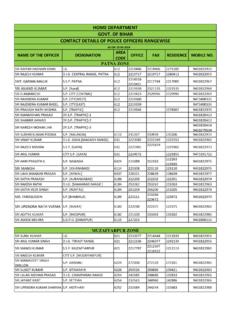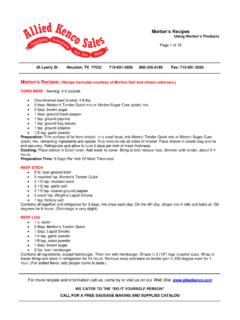Transcription of Meat Pigment Chemistry - Department of Mathematics
1 Page 1 of 3 Meat Pigment Chemistry Taken from IFT Mini-Experiments in Food Science Series Color is the most common quality indicator used by consumers to judge meat freshness. If the color of meat is not correct, a consumer may think that the product is spoiled or not as nutritious. Meat color may indicate microbial spoilage, but it is not a good indicator of nutritional quality. By understanding the many factors that influence meat color, we can manage color stability in meat products and maximize consumer quality perception. Unlike plant product color, the Chemistry of meat color is primarily the Chemistry of one Pigment , called myoglobin. Myoglobin is a complex protein, similar in function to the blood Pigment , hemoglobin, in that they both bind with the oxygen, which is required for metabolic activity of an animal. Although their functions are similar, their roles are different: hemoglobin acts as an oxygen carrier in the bloodstream, whereas myoglobin is essentially a storage mechanism for oxygen in muscle (meat).
2 The color of meat from various species, such as poultry, pork, and beef, often differs in redness, and one cause of this difference is the amount of myoglobin in the meat. In muscle immediately after slaughter, beef meat color is a deep purplish. As oxygen in the air comes in contact with exposed meat surfaces, it is absorbed and combines with myoglobin, turning the meat a brighter color. This brighter red Pigment is called oxymyoglobin. Myoglobin and oxymyoglobin have the capacity to lose an electron (oxidize), which turns the Pigment to a brown color called metmyoglobin. Myoglobin, oxymyoglobin, and metmyoglobin can all be changed from one to the other when the appropriate conditions exist. These pigments change considerably when meat is cooked. A brown Pigment , which is denatured metmyoglobin, is formed with cooking, which normally cannot be changed to form another Pigment .
3 Historically, salt has been used for the preservation of meat. The salt-preserved meat product was usually brownish-gray in color. When sodium nitrite is added with the salt, the meat develops a red, then pink color, which is associated with cured meats such as ham, bacon, hot dogs, and bologna. Nitrite reacts with the meat myoglobin to cause these color changes, first converting to nitrosomyoglobin (bright red), then, on heating, to nitrosohemochrome (a pink Pigment ). Demo I. Fresh meat pigments Preparation Time 15 minutes Laboratory Time 1-2 hours Purchase a tightly packed package of fresh ground beef, such as a 5-pound chub package in plastic casing. Place the ground beef chub on a cutting board and slice across the length in the center of the chub. Page 2 of 3 Make another cut about 1 inch from the first to form a hamburger patty. Place the patty on a white paper plate and observe the color near the edge of the patty and near the center.
4 Students should observe color differences, which are due to the amount of oxygen that entered the different parts of the meat. (NOTE: Depending on the freshness and packaging of the ground beef, there may or may not be color differences). Students should also observe that as oxygen in the air reacts with myoglobin, oxymyoglobin is formed and a bright red color results. Cut off two 1-inch thick patties. Wrap one patty using Saran wrap, which is oxygen impermeable. Use oxygen permeable HandiWrap to wrap the second patty. Place each of the patties on a white paper plate. Refrigerate the patties and observe color changes over the next 1 to 2 hours. (NOTE: This demonstration could be started earlier than audience arrival). Students should observe that the patty wrapped in HandiWrap has a bright cherry red color (oxymyoglobin) while the patty wrapped in Saran Wrap is changed to a purplish-red color (myoglobion).
5 Demo II. Cured meat pigments Preparation Time 15 minutes, more if some steps are prepared beforehand Laboratory Time 45 minutes Divide 200 g of raw hamburger into two equal batches. Put one batch of hamburger into a plastic bag. Dissolve g of sodium nitrite into 10 ml of water, then add ml of the solution to the meat. DO NOT pipette by mouth. (The instructor, not students, should handle the sodium nitrite). Mix thoroughly by kneading the bag for about 3 minutes. Stuff each batch of hamburger into a labeled beaker. Pack it down tightly to get rid of as much air as possible. Cover the beakers with HandiWrap . Place the beakers in a refrigerator overnight (NOTE: This could be done beforehand). The next day, remove the beakers from the refrigerator and observe the color of the surface and the interior of the meat. Students should observe that the color of the meat containing nitrite is brighter red (nitrosomyoglobin) compared to the meat without nitrite.
6 Page 3 of 3 Cook the meat by heating the beakers in a boiling water bath for 15 to 20 minutes; observe the color of the surface and the interior of the meat. (NOTE: This could be done beforehand). Students should observe that the cook color of the non-nitrite meat is brown or brownish-gray, while the color of the nitrite meat is dark pink to red.












